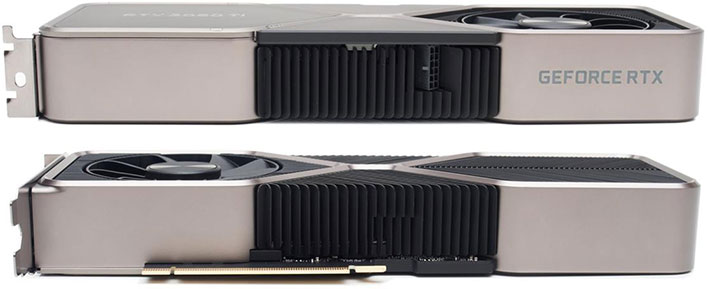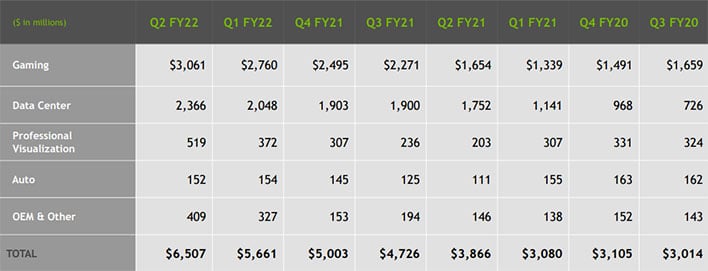NVIDIA Crushes Q2 Earnings On Booming Gaming Demand, Expects GPU Shortages Through 2022

NVIDIA just posted another monster quarter, this time raking in a record $6.51 billion in revenue during Q2, representing a massive 68 percent increase from the same three-month period last year. A significant chunk of that is profit—NVIDIA reported net income of $2.37 billion, up 24 percent sequentially and a mind-boggling 282 percent year-over-year. Clearly the graphics card shortage is not holding NVIDIA down, in terms of revenue and profit.
This is despite seeing lower than expected sales of CMP graphics cards specifically built for cryptocurrency mining, which still earned the company $266 million during NVIDIA's second quarter of its fiscal 2022, but fell short of the $400 million it anticipated collecting from the segment. No matter, because NVIDIA otherwise crushed it.
On the heels of introducing its GeForce RTX 30 series (and recently fleshing it out with the additions of the GeForce RTX 3080 Ti and GeForce RTX 3070 Ti), NVIDIA saw its Gaming revenue jump 85 percent year-over-year to a record $3.06 billion. Likewise, NVIDIA noted big gains in its Data Center revenue—it increased 35 percent year-over-year to $2.37 billion, which also set a record.
Gaming remains NVIDIA's bread and butter, and to that end, there is plenty of room to boost its bottom line with more Ampere sales in the months ahead. During an earnings call to discuss the results, NVIDIA CEO Jensen Huang said the demand for RTX graphics cards "is quite incredible," but still only in the hands of "20 percent of our total installed base. So there's another 80 percent of the world's PC gaming market that we have yet to upgrade to RTX."
As good as NVIDIA's second-quarter earnings were, its third-quarter performance could potentially be even better.
NVIDIA Expects GPU Shortage To Linger Throughout 2022

The number of RTX card owners will inevitably go up as time goes on, though it partially depends on NVIDIA's ability to source more GPUs. Therein lies half of the challenge, with a global shortage of silicon affecting the technology industry as a whole.
Jensen touched on this during the earnings call, and unfortunately for PC gamers, next year could be another frustrating one, as it applies to finding GPUs in stock and selling near the MSRPs.
"We have enough supply to meet our second-half company growth plans and next year, we expect to be able to achieve our Company's growth plans for next year.
Meanwhile..I would expect that we will see a supply-constrained environment for the vast majority of next year is my guess at the moment," Jensen said.
Earlier in the call, NVIDIA's chief financial officer, Colette Kress, noted that "Gaming [GPU] demand is continuing to exceed supply as we expect channel inventories to remain below target levels as we exist Q3." So in other words, there is not going to be any immediate relief to the shortage, with demand remaining "exceptionally strong," and next year is likely to be more of the same.
That's a bummer, though not unexpected. NVIDIA's comments on the shortage essentially echo what other major players have warned, including IBM, Intel, and TSMC, all of which have said it might be 2023 before the industry gets a handle on things. It's not what we like to hear, but it is the reality of the situation. At least for NVIDIA and its investors, the company is still making money hand-over-fist.


